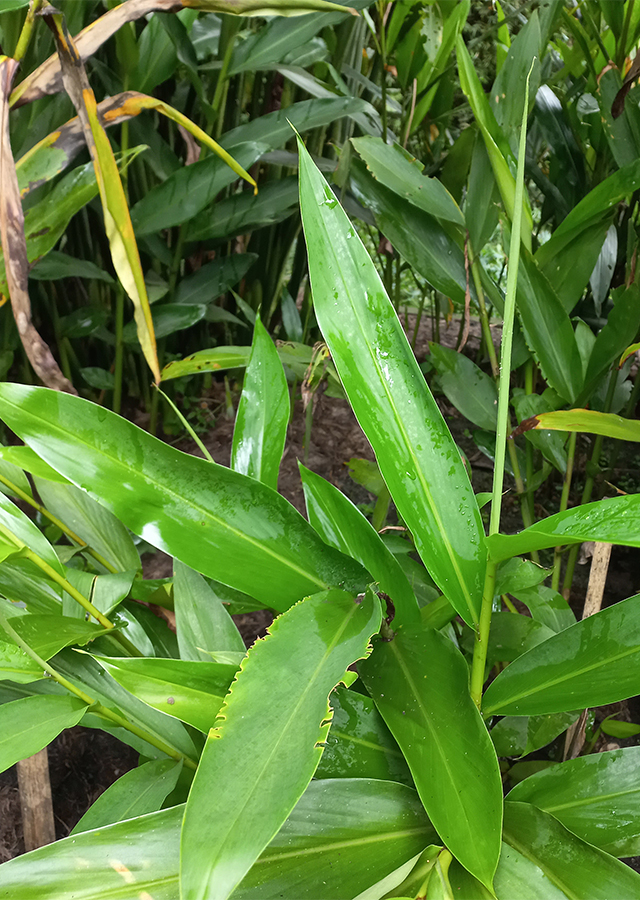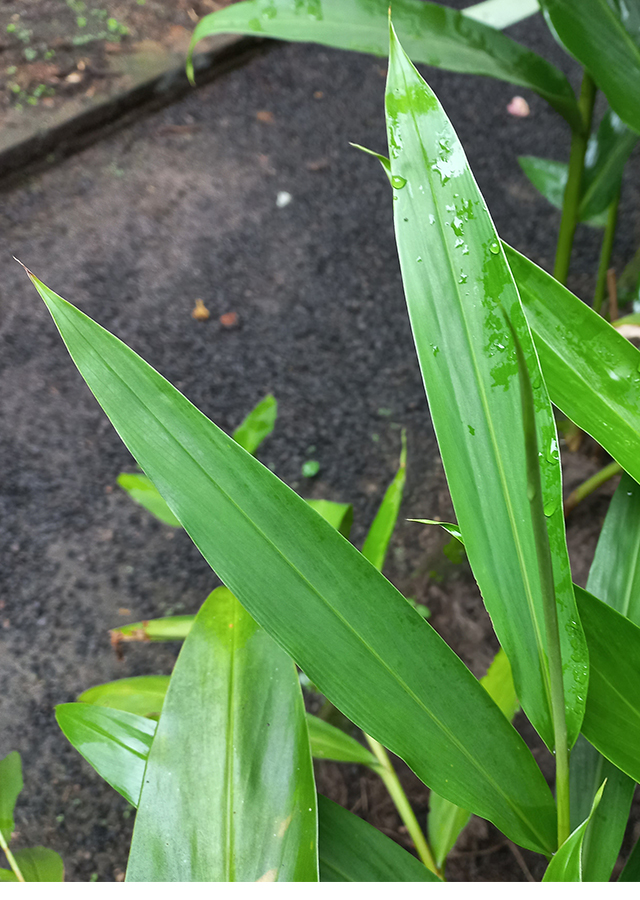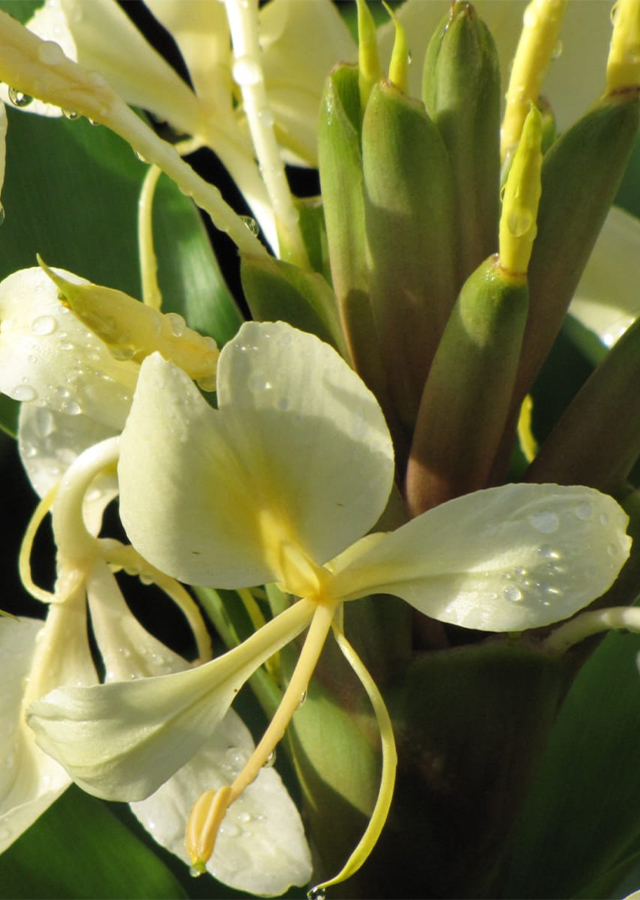Yellow ginger
Hedychium flavescens Carey ex Roscoe
Zingiberaceae
Location in our garden
Principal



Synonym
Hedychium emeiense Z.Y.Zhu
Hedychium panzhuum Z.Y.Zhu
Hedychium subditum Turril
Habitus
Herbaceous. Perennial herb with thick fleshy rhizomes and erect, leafy pseudostems of 1-3 m in height.
Part Used
Stem
Rhizome
Growing Requirements
Full Sunshine
Habitat
Riverbanks
Forest
Roadside
Terrestrial
Overview
Hedychium flavescens is native to the eastern Himalayas, including Nepal and north-eastern India (Assam, Meghalaya and Sikkim). Herbarium records from India’s Central National Herbarium also report localities as far south as Kerala and Tamil Nadu. However, H. flavescens is now widely introduced and naturalized in various tropical countries, and was probably introduced to areas neighbouring its native range. In the eastern part of its range, it is often planted around Buddhist shrines. H. flavescens has been introduced to many locations around the world as an ornamental and subsequently escaped cultivation to become a weed of significant economic importance in countries with favourable moist and warm climates. An extract of the root is used as an ingredient in commercial cosmetic preparations as an emollient. An essential oil obtained from the rhizome contains beta-pinene. The oil has been shown to be an effective antimicrobial, antibacterial, antifungal, anthelmintic and anti-mosquito activities. This plant is used in several countries as traditional medicine, such as in the Philippines where the stem is used to treat tonsillitis.
Vernacular Names
Cream garland lily, Cream ginger, Cream ginger lily, Yellow ginger lily (English). Gingembre jaune, Gingembre-douleur, Hédychie jaunâtre, Longose, Longose à fleurs jaunes, Longose jaune vanille, Longoze (French).
Agroecology
Hedychium flavescens is a plant of the humid tropics, where it can be found at elevations up to 2,000 metres, occasionally to 2,300 metres. It prefers areas with a mean annual rainfall in the range 1,000 - 5,000 mm, a mean annual temperature of 11 - 20 °C. Being native to high elevations, it can also tolerate cooler temperatures if growing in fully humid climates, and is known to tolerate light to moderate frosts, though they may kill above-ground plant parts. The plant prefers to grow in open, light-filled environments which are warm and moist, but it will readily colonise semi and full shade under forest canopies. Requires a well-drained soil of medium to high fertility.
Morphology
- Rhizomes, thick fleshy rhizomes and erect, leafy pseudostems.
- Leaves are sessile and have slightly pubescent sheaths. The ligule is 3-5 cm long and membranous. Leaf blades are elliptic-lanceolate or lanceolate, 20-50 cm long and 4-10 cm wide and abaxially (beneath) pubescent with attenuate base, membranous margins and a caudate-acuminate apex. Inflorescences are oblong spikes, 15-20 cm long and 3-6 cm wide; bracts are imbricate, oblong to ovate, 3-4.5 cm long and 2-4 cm wide, concave, 4- or 5-flowered. The bracteoles are tubular and membranous.
- Flowers are creamy-white to pale yellow or yellow-white in a cone like inflorescence, fragrant with yellow stamens. The calyx is 3.5-4 cm long, pubescent, approximately half the length of the corolla tube and almost as long as the bract. It is split on 1 side, apical margin entire. Corolla tube is 7-8.5 cm, long and slender. The lobes are linear, 3-3.5 cm long. The lateral staminodes are wider than the corolla lobes. The labellum is erect, creamy yellow with an orange patch at base, obcordate, longer than wide, and apex is 2-lobed. Filament is white to cream, subequaling labellum. Top of anther protruding slightly beyond lip. Ovary hairy. Stigma funnelform, margin earded.
- Fruits are globose capsules 1-2 cm in diameter with three valves, containing numerous seeds but not seen in much of its invasive range.
Cultivation
Spread in its invasive range is mainly by vegetative growth via rhizomes, however, in Hawaii some evidence exists that H. flavescens may be naturalizing by seed, though no fertile fruits have yet been found.
Chemical Constituents
Cardiac glycosides, phenols, saponins, alkaloids, tannins, phlobatins, terpenoids, pinene, sesquiterpenes.
Traditional Medicinal Uses
- Medicine for swelling of the throat, treating broken bones, asthma.
- The oil has been shown to be an effective antimicrobial.
- In Philippines, stem used to treat tonsillitis.
Part Used
Reference Sources
- CAB International. 2019. Hedychium flavescens (wild ginger). https://www.cabi.org/isc/datasheet/107733. 2-11-2021.
- Flora Fauna Web. Hedychium flavescens. https://www.nparks.gov.sg/florafaunaweb/flora/8/1/8103. 2-11-2021.
- Useful Tropical Plants Database. 2021. Hedychium flavescens. http://tropical.theferns.info/viewtropical.php?id=Hedychium+flavescens. 2-11-2021.


